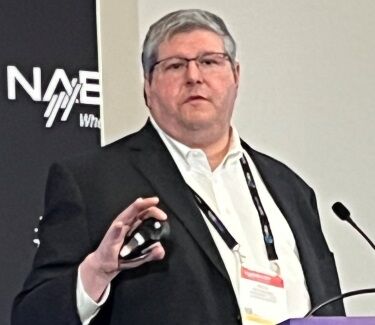Paying attention to your station’s metadata and how it looks on the more robust displays and larger screens in today’s connected cars is becoming more important. Radio and audio delivered by multiple platforms enable a richer user experience by combining audio with visual content, such as text, image and contextual data.
About 80% of the cars on the road in North America can display visual content using either RDS or HD Radio. And more than 25% can display rich content, using HD Radio or hybrid technology.
“That's quite significant,” Richard Redmond, President & COO of Broadcast Electronics – Elenos Group, said this week at NAB Show 2024 in Las Vegas. “Using the combination of sound and visual content is a powerful tool for radio operators to build a deep connection with their listeners, community and advertisers.”
Managing station metadata is vitally important in light of a recent study conducted by Westwood One and MARU/Vision Critical. The data showed 70% of listeners said they pay attention to what's showing up on the radio screen. And in an eye-opening finding for advertisers, two thirds of regular radio users recall seeing visual content displayed on their car dashboard and remember the retailer’s radio ads. Moreover, nearly 85% of listeners who recalled the radio ad with visual content indicated they planned to or had visited the advertised retailer’s location. That’s 12% more than those who didn’t see the visual content.
Among ad agencies familiar with the technology, nearly 75% are interested in using visual content to go along with their message and are willing to pay a nearly 15% premium to include a visual with their ad. “High resolution displays in vehicles deliver higher recall and engagement with consumers and advertisers are interested in investing in that,” Redmond said during the Broadcast Engineering and IT Conference session entitled “Radio Visual Content Delivery – Metadata Management.”
But opportunities created by visual displays on car dashboards aren’t confined to just augmenting the commercials. They can also be used to promote a station event, morning show or something that's happening related to the station. Or used to display real-time sports scores during broadcast play-by-play or a headline during a newscast. The use of images is only limited by your creativity, Redmond said.
To do this requires the use of a metadata management system, the cloud-based middleware that allows radio operators to organize all their metadata and send it to all the audio platforms used by consumers.
Redmond described it as an interface that sits between the sources of metadata that accompany a station’s content and the multiple platforms the station uses to reach listeners. The system links to all the major audio playout systems, program service providers, open-source music, news and weather feeds. All these sources are scheduled, monitored and managed to provide a clear and visually appealing feed to consumers via radio, streaming webpages and mobile apps or wherever listeners consume the station’ content.
The use of rich graphics in mobile phones and streaming platforms has increased consumer awareness and expectations of visual content. “Audio without visual content leaves an impression the listener is missing something, Redmond said. “Visual content also heightens listener engagement and opens new revenue opportunities.”

